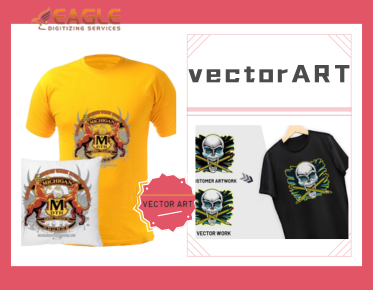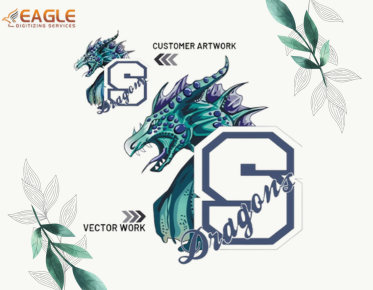Why do we need the power of vectorized logos?
In the bustling world of branding, logos are the superheroes. They represent the essence of a company in a single, memorable image. But what makes a logo truly exceptional and versatile? The secret lies in vectorization. Let’s dive into why logo vectorization is not just a good idea, but a necessity.
The
Magic of Logos: First Impressions Matter
People often see a brand's logo first. It’s the face of the company, the first handshake, the initial glance. First impressions count, and an effective logo design may have a lasting impact on consumers. It conveys professionalism, creativity, and trustworthiness in a fraction of a second. In a crowded marketplace where competition is fierce, a well-crafted logo can make all the difference, helping a brand stand out amidst the noise and leave a lasting impression on consumers' minds.
The Power of Visual Identity
Visual identity is the cornerstone of brand communication, providing a cohesive and consistent visual language that conveys the brand's personality, values, and positioning. Logos play a central role in shaping this visual identity, serving as the linchpin that ties together various brand elements such as color schemes, typography, and graphic motifs. A strong visual identity not only enhances brand recognition but also fosters brand loyalty and affinity among consumers, creating a sense of connection and resonance that goes beyond mere transactions.
What
Exactly is Logo Vectorization?
Understanding the Basics of
Vector Graphics
Vector graphics are all about precision. Unlike raster images,
which are made up of pixels, vector images use mathematical equations to create
lines and shapes. This means they can be resized infinitely without losing any
quality. They’re sharp, clean, and incredibly flexible.
Why Vectorization Beats Raster
Every Time
Raster images, like JPEGs and PNGs, can look great at their original size but tend to lose quality when scaled up. Think of a pixelated mess. Vectorization ensures that logos remain crisp and clear, whether they’re on a business card or a billboard. It’s the difference between amateur and professional.
The
Flexibility of Vector Logos
Scaling Without Losing Quality:
Small to Billboard Size
At the heart of every impactful logo lies the concept of scalability
and versatility, traits that are inherent to vector logos. Unlike raster
images, which are composed of individual pixels and prone to distortion when
resized, vector logos are based on mathematical equations and can be infinitely
scaled without loss of quality. This scalability makes vector logos ideal for a
wide range of applications, from tiny icons on digital screens to
larger-than-life billboards and everything in between. No blurriness, no
distortion. Just pure, scalable perfection.
Adaptability Across Different
Mediums
Vector logos aren’t just for print. They seamlessly adapt to
various digital platforms as well. Whether it’s on a website, an app, or a
social media profile, the logo looks impeccable. This adaptability ensures that
a brand’s visual identity remains consistent across all channels.
Crisp and Clear: The
Professional Look
There’s something inherently professional about a vectorized logo. It’s crisp, clear, and exudes quality. It shows that a brand pays attention to detail and values its image. In a world where first impressions are everything, a vector logo stands out as a mark of excellence.
The
Technical Benefits of Vector Logos
Infinite Scalability: From Icon
to Mural
With vector logos, the possibilities are endless. They can be scaled
up to the size of a mural or down to the size of an app icon without losing any
detail. This infinite scalability makes them incredibly versatile for any
application.
File Size Matters: Lightweight
Yet Powerful
Vector files are usually smaller in size than their raster
equivalents. This means they’re easier to store, share, and load, making them
ideal for web use. Despite their small size, they pack a powerful punch in
terms of quality and detail.
Easy Edits and Modifications
Need to change a color or tweak a design? Vector logos make it easy. Because they’re made up of individual elements, you can edit specific parts without affecting the whole design. This flexibility is invaluable for keeping a logo fresh and up-to-date.
Practical Applications of Vector
Logos
Print Perfection: Business Cards
to Banners
In the print world, precision is key. Vector logos ensure that your
brand looks perfect on business cards, brochures, banners, and everything in
between. The quality remains consistent, no matter the size or material.
Digital Dominance: Websites,
Apps, and Social Media
Digital platforms demand versatility. Vector logos can be resized and
adapted to fit any screen size and resolution, ensuring your brand looks sharp
on websites, apps, and social media. This digital dominance is crucial in
today’s tech-driven world.
Merchandising: T-Shirts, Mugs,
and More
When it comes to merchandising, vector logos shine. They can be printed on a variety of products like T-shirts, mugs, and hats without losing quality. This makes them perfect for brand promotion and merchandise.
Logo
Vectorization: The Process
From Concept to Vector: A
Step-by-Step Guide
Creating a vector logo starts with a concept. Sketch out your ideas,
then use vector software to bring them to life. Outline the basic shapes,
refine the details, and adjust the colors. The result is a polished, versatile
logo that’s ready for anything.
Choosing the Right Tools:
Software and Techniques
There are several software options for vectorizing logos. Adobe
Illustrator is the industry standard, offering a plethora of tools and
features. Other options include CorelDRAW and Inkscape. Choose the one that
fits your needs and get comfortable with its features.
Manual Tracing vs. Auto-Vectorization
Manual tracing involves outlining an image by hand, which allows for precise control and customization. Auto-vectorization, on the other hand, uses algorithms to convert raster images to vectors. Both methods have their place, but manual tracing often yields higher-quality results.
Common
Challenges in Logo Vectorization
Dealing with Complex Designs
Complex designs can be tricky to vectorize. They require careful
attention to detail and may need to be simplified for better scalability. Breaking
the design into manageable parts can help in achieving a clean vector version.
Maintaining Brand Consistency
Consistency is crucial in branding. When vectorizing a logo, it’s
important to maintain the brand’s colors, shapes, and overall style. This
ensures that the vector logo aligns with the brand’s identity and looks
consistent across all applications.
Avoiding Common Pitfalls
Common pitfalls in logo vectorization include over-complicating the design, neglecting scalability, and using the wrong file formats. Avoid these mistakes by keeping the design simple, testing it at various sizes, and saving it in appropriate formats like SVG or EPS.
Case
Studies: Successful Vectorized Logos
Famous Brands and Their Vector
Logo Transformations
Many famous brands have undergone logo vectorization to enhance their
visual identity. Companies like Nike, and Apple have vectorized logos that are
instantly recognizable and versatile. These transformations highlight the power
of vectorization in modern branding.
Before and After: The Impact of
Vectorization
Seeing the before and after of a logo vectorization can be striking. Raster logos often look dated and pixelated when resized, while vector logos appear sleek and professional. These transformations demonstrate the tangible benefits of vectorization.
DIY
Vectorization vs. Hiring a Pro
Pros and Cons of DIY
Vectorization
DIY vectorization can be a cost-effective option, especially for small
businesses. However, it requires a good understanding of vector software and
design principles. The learning curve can be steep, but it offers creative
control and flexibility.
Finding the Right Professional
for the Job
Hiring a professional ensures high-quality results. Look for a
designer with experience in logo vectorization and a strong portfolio. They can
offer expertise, creative input, and a polished final product that aligns with
your brand’s vision.
Cost vs. Value: Investing in
Quality
Investing in professional logo vectorization can be more expensive upfront, but the value it provides is substantial. A high-quality vector logo can enhance your brand’s image, increase recognition, and provide long-term benefits that outweigh the initial cost.
Maintaining
Your Vector Logo
Best Practices for Storing and
Sharing
Store your vector logos in multiple formats and locations to ensure
they’re always accessible. Use cloud storage for easy sharing and backups. Keep
organized folders with clear file names to avoid confusion.
Regular Updates and Tweaks
Brands evolve, and so should logos. Regularly review your vector logo
and make necessary updates or tweaks to keep it fresh and relevant. This proactive
approach ensures your logo always represents your brand accurately.
Future-Proofing Your Logo
Future-proof your logo by creating versatile designs that can adapt to new trends and technologies. Keep editable files handy and consider potential changes in branding or industry shifts. A well-prepared logo can stand the test of time.
The
Role of Vector Logos in Branding
Building a Strong, Consistent
Brand Identity
A strong, consistent brand identity is key to building trust and
recognition. Vector logos play a crucial role in this by providing a reliable
and adaptable visual element that reinforces the brand across all platforms.
Enhancing Brand Recognition
Consistency in logo design enhances brand recognition. A vector logo
ensures that your brand’s image is always sharp, clear, and memorable, whether
seen on a tiny screen or a large billboard.
The Competitive Edge: Standing
Out in the Market
In a crowded market, standing out is essential. A vector logo gives
your brand a competitive edge by presenting a professional, polished image that
attracts and retains customers. It's an investment that will result in
increased brand loyalty and recognition.
Summing
Up: The Power of Vectorized Logos
Vectorized logos are powerful tools in the branding arsenal. Eagle Digitizing offers vector art conversion services that make these logos even more valuable. They offer scalability, flexibility, and a professional look that raster images simply can’t match. From tiny icons to massive murals, vector logos maintained through Eagle Digitizing's services maintain their quality and integrity, making them indispensable for modern branding.
Ready to elevate your logo to a higher level?
Start by assessing your current logo’s needs and exploring the vectorization options provided by Eagle Digitizing.
Whether you DIY with their assistance or hire a professional through them, the
benefits of a vectorized logo are clear. Embrace the power of vectors with
Eagle Digitizing and watch your brand flourish.



